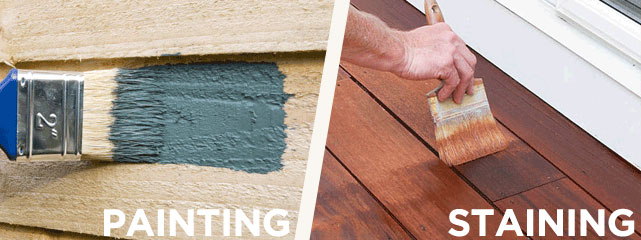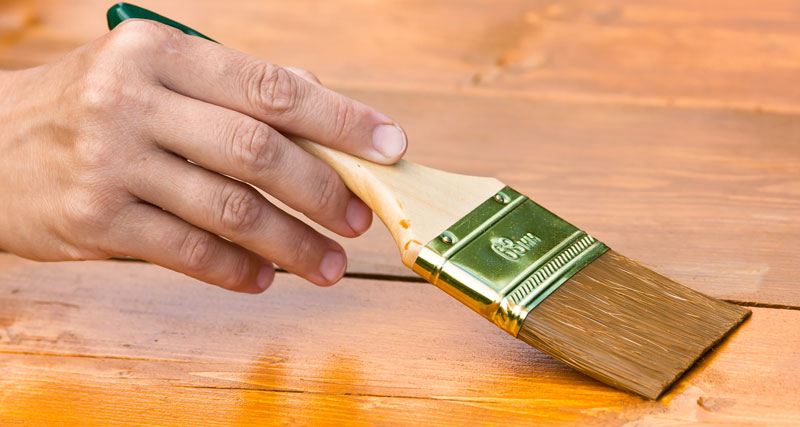Wood is one of the strongest and durable materials used for both indoors and outdoors in the production of floorings and furnishings. To ensure that such an organic material is able to withstand the test of time and enhance its aesthetic appeal some protective coating needs to be applied on its surface. This can either be in the form of paint or stain.
While a stained woodwork will look good initially but over the years it can wear out to give a very sloppy appearance. Although painting over stained wood is a bit difficult than repainting on the surface it will indeed be a long-lasting solution.
 Image Credit: Cabotstain.com
Image Credit: Cabotstain.comShould You Stain Or Paint Wood First?
This is a choice best left in the hands of the user. However, staining before painting is normal. This is because if the process is messed up it can easily be painted over stain but the other way round is a bit difficult. However, if such a task is performed under the supervision of a professional painter then either way is possible.
But whichever way is chosen it is always recommended to let the surface dry up completely before masking and proceeding with the next step. Otherwise, the entire surface is likely to get spoiled.
Can Different Stain colors Be Combined?
Many people think of mixing different stain colors to get a new and attractive look. Some even try to apply two different stain colors over the same surface.
If you plan to do so, never mix the colors in a single container. Instead, start by applying the lighter stain color first and then cover up with a darker color.
But remember not to mix up different bases of stains. This means you should not mix water-based stains with the oil-based ones. Otherwise, the stain will gradually wear out and not hold on to the surface properly.
Painting Over Stained Woodwork
There are certain steps that need to be followed while painting over a stained wood surface to ensure that the stain does not bleed through the paint surface resulting in discoloration. This is best known by the professional Princeton Painters who are experienced and trained to deliver such task in the best way possible.
 Image Credit: iStock/PavelRodimov
Image Credit: iStock/PavelRodimov- Check for polyurethane over the stained wood surface. If such a presence is detected then it should be removed by scuffing the surface with fine sandpaper. This will improve the bonding of the primer that will be applied on the stained surface.
- After the scuffing is done a stain killing primer needs to be applied. This needs to be a slow drying oil-based primer. Leave the primer to dry overnight.
- Any nail holes need to be covered up with putty. Using window glazing putty works best because of its non-shrinking property. Rub off any extra putty on the trim surface before applying the paint.
- The stained wood surface is now ready for painting. Double coats of semi-gloss painting will provide a nice smooth and shiny look.
Is Applying Wood Conditioner Mandatory?
This completely depends on the wood surface on which the staining and painting work is done and the desired final look. Pinewood surfaces are known for blotchy stain finishes. Therefore, applying wood conditioner over such surfaces becomes mandatory for a more toned stain.
On the other hand, when restyling or refinishing primitive furniture and woodwork in New Jersey wood conditioner is often not necessary as a stained surface isn’t needed for such pieces. If you are comfortable with slight variations then wood conditioner is not necessary.
Essential Tips For A Long-lasting Painted And Stained Surface
The durability of such painted and stained surface is also dependent on its exposure to the natural elements of wind, rain, and sunlight.
- Certain specific type and colors of paint are more susceptible to chalking and fading than the others, such as darker shades are more prone to fading than their lighter counterparts. Professional painting contractors in Hopewell can provide valuable guidance on the proper selection of paints that will perform better in specific climatic conditions.
- It is necessary to inspect the painted and stained surface on a periodic basis. Although there is no standard schedule for exterior stain or paint reapplication, it is the responsibility of the homeowner to be vigilant of any marked changes.
- Signs of premature aging and deterioration if corrected well no time can extend the life of the furniture.
- Ensure the painted and stained surface is free and clean from debris. Adequate ventilation should be provided to exposed surfaces to ensure that dust or dirt does not settle on the surface.
- For woodwork kept in interior locations, such as in bathrooms, kitchens, and laundry rooms, mechanical ventilation should be used to provide free flow of air.
Bottom Line
Whatever you decide, take some time and then take the decision. Do not make any decision just because you liked a woodwork finish somewhere else. Just make sure that you follow the steps as mentioned above to ensure that you have the best possible outcome. For professional wood painting and staining services, you can connect with Princeton Painters. We’ll beat any quote you may give us.


